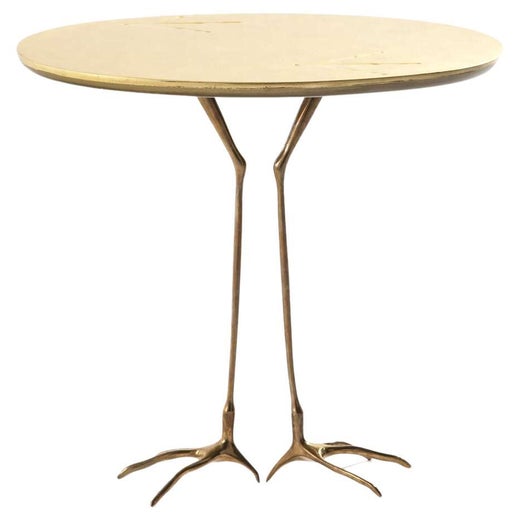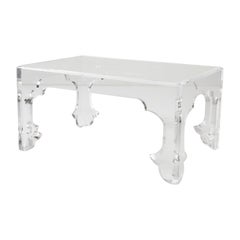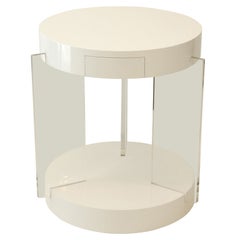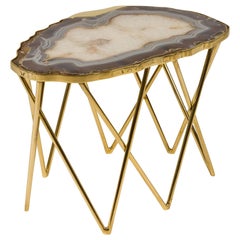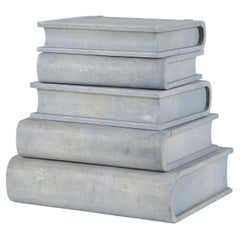Traccia Table by Meret Oppenheim
About the Item
- Creator:Meret Oppenheim (Designer)
- Dimensions:Height: 25 in (63.5 cm)Width: 26.75 in (67.95 cm)Depth: 20.75 in (52.71 cm)
- Place of Origin:
- Period:
- Date of Manufacture:1939/1971
- Condition:Wear consistent with age and use. Surface scratches and a previous repair to the gold leafing.
- Seller Location:Palm Desert, CA
- Reference Number:1stDibs: 13030879771937
Meret Oppenheim
Though the fame of the sculptor and painter Meret Oppenheim stems mainly from a single work of art, that one was a doozy. Known as Object, the enduringly disconcerting fur-covered teacup, saucer and spoon that Oppenheim created in 1936 remains the one of the most notorious works to spawn from the Surrealist art movement.
Born in Germany and raised in Basel, Switzerland, Oppenheim was encouraged to pursue art by her maternal grandmother, a writer and illustrator. Oppenheim moved to Paris to attend art school in 1932. There, she met the sculptor (and fellow Swiss native) Alberto Giacometti, who introduced her to Man Ray, Max Ernst and André Breton, the founder of the Surrealist movement. Within a year, Oppenheim was exhibiting her paintings with the Surrealists, the first female artist to do so.
Object, the story goes, was born of a lunchtime chat that Oppenheim had with Pablo Picasso and his muse, artist Dora Maar, one afternoon in 1936. The Spanish-born artist admired an unusual fur-lined bracelet that Oppenheim wore, and she replied that anything could be covered fur, “even this cup and saucer!” Her imagination fired, Oppenheim bought some china and a swatch of Chinese gazelle fur. When it was exhibited in New York, Object was purchased by the Museum of Modern Art — the first work of art by a woman acquired by the institution.
Another Oppenheim piece has become an icon of the art-as-design genre, a category that has currency among art collectors: the Traccia table, a side table with a gold- or silver-leafed wooden top, incised with the shapes of two bird-claw impressions, and a cast-bronze base in the form of stork legs. The Traccia — from the Italian for “track,” as in animal track — was created for the 1939 opening of art dealer Leo Castelli’s first gallery, on the Place Vendôme in Paris. The maker Simon International began producing versions of the Traccia in 1970, and the piece is now made by Cassina. Examples are typically priced between $6,300 and $8,500, depending on condition. As striking and amusing today as when it first appeared, the Traccia is an always-suave addition to a modern art and design collection and a tribute to the humor and ingenuity of a groundbreaking 20th-century artist.
Find original Meret Oppenheim art and furniture on 1stDibs.
You May Also Like
20th Century Italian Mid-Century Modern End Tables
Brass, Gold Leaf
Vintage 1970s Italian Mid-Century Modern Side Tables
Bronze, Gold Leaf
2010s Italian Mid-Century Modern Side Tables
Steel
2010s Italian Mid-Century Modern Side Tables
Steel
2010s Italian Mid-Century Modern Side Tables
Steel
2010s Italian Mid-Century Modern Side Tables
Steel
2010s Italian Mid-Century Modern Side Tables
Steel
Vintage 1970s Italian Post-Modern End Tables
Bronze, Sheet Metal
2010s Italian Mid-Century Modern Side Tables
Bronze
Vintage 1970s Italian Mid-Century Modern Side Tables
Bronze, Gold Leaf
More From This Seller
View AllVintage 1980s American Mid-Century Modern Coffee and Cocktail Tables
Lucite
21st Century and Contemporary American End Tables
Lucite, Wood
2010s American Mid-Century Modern Side Tables
Amethyst, Agate, Brass
Vintage 1980s American Mid-Century Modern Side Tables
Shagreen, Oak
21st Century and Contemporary American Mid-Century Modern Cabinets
Metal
2010s American Table Lamps
Ceramic, Wood
Still Thinking About These?
All Recently ViewedRead More
In Dragonette’s New Palm Desert Digs, Great Design Springs Eternal
Since leaving Los Angeles, Patrick Dragonette is experiencing a new kind of creative freedom.
Why This L.A. Designer Prefers Soulful Sophistication over Snobbism
Mallery Roberts Morgan practices a singular brand of creative fluidity as a writer and a quietly influential interior designer.
